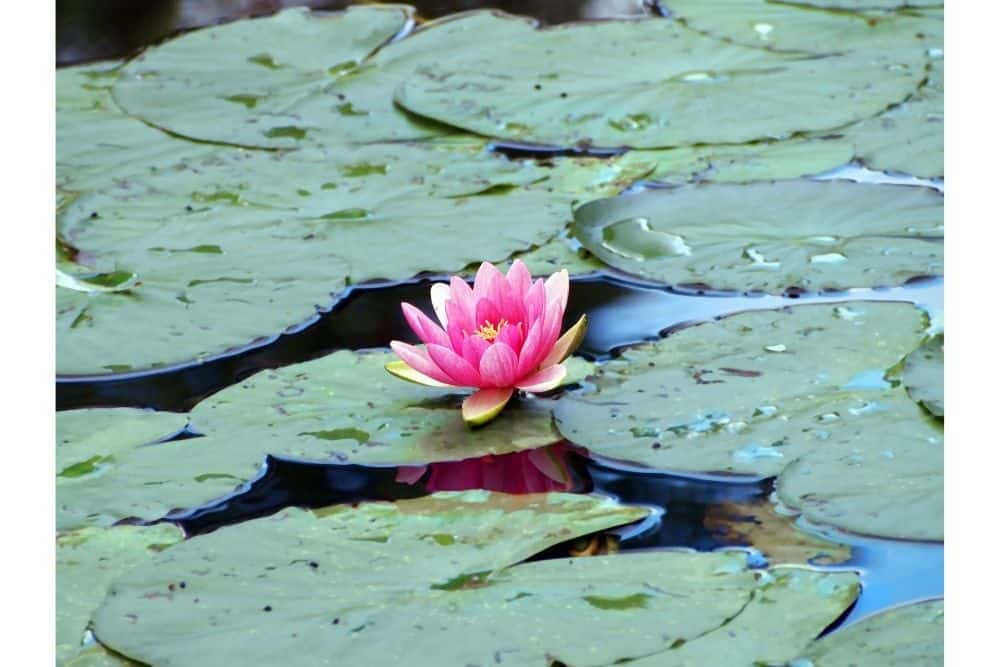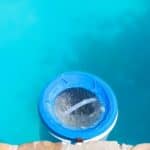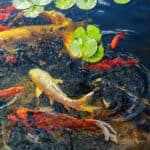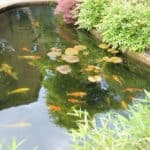There are many ways to help keep your pond water clean without resorting to the use of chemicals. One of our favorite ways to do this is by creating a large filter and running the pond water through it.
You will need a container that is larger than your pond pump. It should have holes on all sides to encourage water to flow through and should be strong and waterproof.

Good resources to use for this include a milk crate or a plastic basket. You will also need a submersible, recirculating pond pump, and polyester quilt batting.
Place the pond pump into the crate and attach a hose. This will direct the output water out of the crate. Cover the exterior of the plastic crate in the polyester batting. Cover all areas of the plastic crate to maximize the efficiency of the filtration system.
Put the plastic crate into your pond and submerge it completely. If necessary, you can weigh the crate down with rocks. Start the pump and monitor the progress at regular intervals. The quilt batting will collect the algae and debris from the pond and will begin to discolor.
When you notice that the output hose flow has weakened, or the batting is very dirty, you will need to replace the batting. The frequency with which you will need to do this will vary according to the size of the pond, the strength of the pump, the water’s dirtiness, and the batting.
How do I keep my pond full of water?
There are many steps that you can take to ensure your pond remains as full of water as possible. The first step is to choose a good location for your pond. It should be shaded for at least part of the day.
This prevents the water from evaporating too quickly while allowing your plants to receive the sunlight that they need to survive.
You should also install a liner underneath your pond. These tend to be made from PVC or rubber and are designed to prevent the pond water from seeping into the ground underneath.
If you want to put plants in your pond, you will need to place pots at the bottom of the pool to provide soil for them to grow.
You can also add in some water plants. These plants live on the surface, like water lilies. They prevent the water in your pond from evaporating as rapidly. You could also consider constructing a windbreaker to stop the wind from blowing water out of your pond.
How do I make my pond safe?
There are many ways that you can keep your pond safe from children and pets. A garden pond is a great way to teach your children about nature and aquatic wildlife, but they can be dangerous.
You should not leave your children unattended by your pond in case they fall in and drown. Even if they do not drown, there are potentially thousands of harmful bacteria living in the water. This could result in them becoming very ill if they were to swallow any of the water.
A good way to keep your pond safe is by erecting a fence around it. The fence should be at least 1 meter high to ensure safety. This can be as simple as a wire fence, or for a more aesthetic appearance, consider a wooden picket fence.
You could also consider investing in a moveable fence if aesthetics are important to you.
Alternatively, you could opt for a pond cover. These tend to be made from grills or mesh and lie on the surface of the water. They are very strong and will prevent children and animals from falling into the water.
You should also consider the water quality. If your children are old enough to be around the pool then you must ensure the water is safe. Try to avoid using chemicals in the water and opt for natural pond care products where necessary.
How do you keep a pond healthy?
You must take the time to maintain your pond. If you do not do this, your pond can quickly become disgusting, unsightly, and harmful to the aquatic life living there.
You should clean your pond regularly. At a minimum, you need to remove leaves and sludge from the water. The leaves release toxic gases as they decay, which causes serious imbalances in the pond water.
Sludge will collect at the base of your pool and should be removed using a vacuum. Leave a little on the base to help support algal growth.
You could consider installing a trap net on the surface of your pond with a filter mat underneath. This will collect any leaves that fall onto the surface and will also help to protect the aquatic life from predatory animals.
During the winter months, you should monitor the ice levels in the pond. If a layer of ice forms on the surface, the water below will not receive as much oxygen and the water temperature will drop. Both of these things are very harmful to the animals living in your pond.
There are many ways to protect your pond from ice. You could float a ball on the water’s surface to prevent the ice from forming initially. You could also install a heater.
What plants keep a pond clean?
There are a huge number of plants that can be grown in your pond to help keep the water clean and clear. They also have the added benefit of supporting aquatic life by providing food and shelter.
Plants help to keep the water clear as they release oxygen through the process of photosynthesis. This oxygenates the water and helps fish to breathe, but will also lift debris from the water making it appear clearer.
Plants are also highly effective filters for several substances, including nitrates, nitrites, and ammonia. These compounds all contribute to bad odors and the discoloration of your pond water.
Algae also uses ammonia as a food source. This means that by decreasing ammonia levels in the pond, the chances of algal bloom are reduced.
A good plant to include in your pond is hornwort. This is a rapidly growing plant with a very high metabolic rate. This means that it will act as a very effective filter for your pond.
You will need to prune it regularly to prevent it from becoming overwhelming, but this should not be necessary more often than once per month. It is a very low-maintenance plant and is ideal for beginners.
Another good plant to include in your pond is water lettuce. Again, this plant will grow very fast and filter impurities out of your pond highly effectively.
It resembles a cross between a head of lettuce, a water lily pad, and a large flower. It is a large plant and will provide a decent level of shade for animals living in your pond.
Water hyacinths are another great pond plant option. It is a cross between a lily pad and a hyacinth and will bloom with colorful flowers. It is fast-growing and gives a lot of shade to animals underneath the water’s surface.







